
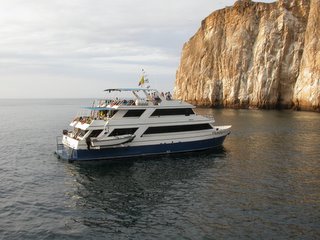 The room is rocking back and forth in Quito as I (Rick) sit at the computer at the Intenet Cafe. This is the after effect of being on this boat in the Pacific for 7 days. Neither of us had sea sickness, but boy there was a lot of rocking and my equilibrium has yet to recover.
The room is rocking back and forth in Quito as I (Rick) sit at the computer at the Intenet Cafe. This is the after effect of being on this boat in the Pacific for 7 days. Neither of us had sea sickness, but boy there was a lot of rocking and my equilibrium has yet to recover.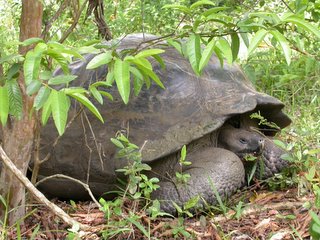
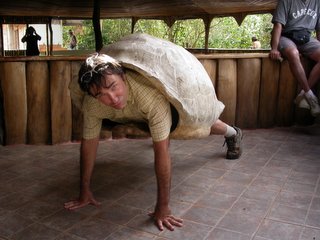
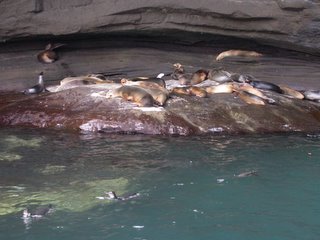 Here are sea lions resting on the rocks, with peguins swimming in front of them, followed by a sea iguana. Practically all the wildlife on the Galapagos has no fear of humans, basically because there has been a relatively small history of hunting by humans on these islands. It is a bit of the blow to the ego when iguanas will pay you no attention when you are one foot away, but will run under a rock if a hawk shows up 500 feet away. Baby iguanas make a tasty snack for the Galapagos hawk which is at the top of the food chain. The hawks will even eat sea lions when hungry enough.
Here are sea lions resting on the rocks, with peguins swimming in front of them, followed by a sea iguana. Practically all the wildlife on the Galapagos has no fear of humans, basically because there has been a relatively small history of hunting by humans on these islands. It is a bit of the blow to the ego when iguanas will pay you no attention when you are one foot away, but will run under a rock if a hawk shows up 500 feet away. Baby iguanas make a tasty snack for the Galapagos hawk which is at the top of the food chain. The hawks will even eat sea lions when hungry enough.Below is a marine iguana that Gary got a great shot of by
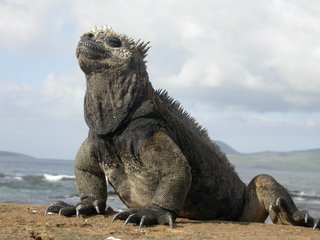 climbing under the ledge on which this iguana is sitting. While we liked these reptiles found only on the Galapagos Islands, Charles Darwin did not care for them. He thought they had a "stupid" demeanor and even called them "imps of darkness." There were places where they were so plentiful and unafraid of humans that we had to be careful to not step on them.
climbing under the ledge on which this iguana is sitting. While we liked these reptiles found only on the Galapagos Islands, Charles Darwin did not care for them. He thought they had a "stupid" demeanor and even called them "imps of darkness." There were places where they were so plentiful and unafraid of humans that we had to be careful to not step on them.These are the most pou
 lar birds on the Galapagos, with the catchy name blue-footed boobies. They are cutely awkward on land and will even do a little mating dance with you if so inclined. But they are incredibly graceful when dive bombing for fish. The islands are also home to the red-footed and Nazca boobies.
lar birds on the Galapagos, with the catchy name blue-footed boobies. They are cutely awkward on land and will even do a little mating dance with you if so inclined. But they are incredibly graceful when dive bombing for fish. The islands are also home to the red-footed and Nazca boobies.The island on the right is typical of the many volcanoes we sailed past, including Daphne Major where landmark studies on the evolution of finches were conducted by Princeton professors Peter and Rosemary Grant and described in the Pulitzer-winning book "The Beak of the Finch".

The islands are geologically young at a mere 20 million years for the oldest and are actively building on the youngest. The last eruption was in September, 2005.
The Galapagos penguin is the second smallest penguin in the world and the only species of penguin to live in tropical waters. The cool ocean currents make them endemic to only the two most western and youngest islands. Again, they are completely unafraid of humans. This photo was taken within three feet as our panga (small boat) past by several times with motor running and cameras clicking. 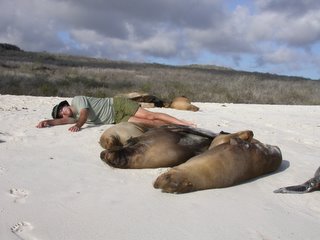
Another bunch of beach bums!



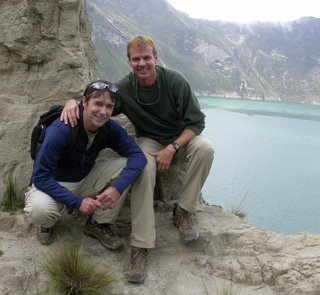

0 Comments:
Post a Comment
<< Home